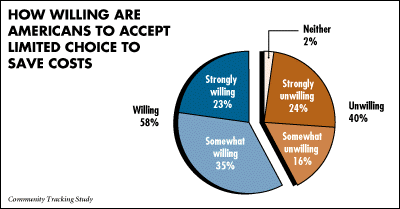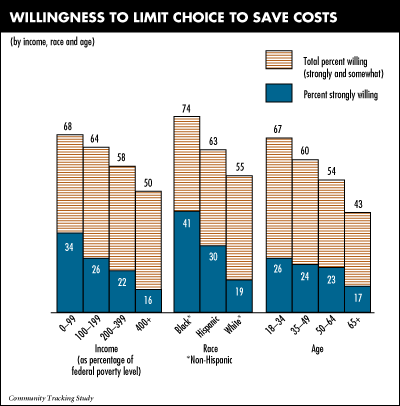
Strong Opinions Held about the Tradeoff Between Choice of Providers and Cost of Care
Data Bulletin No. 04
Fall 1997
Ha T. Tu, Peter J. Cunningham
![]() any Americans are grappling with the tradeoff between wanting to choose their own health care providers and saving on their health care costs, which often involves joining a health plan that limits choice in exchange for lower deductibles, copayments and other out-of-pocket costs. Findings from a survey by the Center for Studying Health System Change reflect this dilemma. The majority of adults interviewed (58 percent) agree with the statement: "I would be willing to accept a limited choice of physicians and hospitals if I could save money on my out-of-pocket costs for health care." But a large minority (40 percent) disagree.
any Americans are grappling with the tradeoff between wanting to choose their own health care providers and saving on their health care costs, which often involves joining a health plan that limits choice in exchange for lower deductibles, copayments and other out-of-pocket costs. Findings from a survey by the Center for Studying Health System Change reflect this dilemma. The majority of adults interviewed (58 percent) agree with the statement: "I would be willing to accept a limited choice of physicians and hospitals if I could save money on my out-of-pocket costs for health care." But a large minority (40 percent) disagree.

Not only are opinions divided, they also are strongly held by many people: 23 percent are strongly willing to accept limited choice and 24 percent are strongly unwilling. An unusually low 2 percent of respondents have no preference.
This divergence of opinion did not vary much among the 12 randomly selected metropolitan areas in the Community Tracking Study. Those willing to accept limited choice ranged from a low of 50 percent in Newark, N.J., to a high of 63 percent in Little Rock.
DIFFERENCES BY DEMOGRAPHIC FACTORS
![]() ignificant differences, however, did emerge by demographic factors. This Data Bulletin reports on differences by income, race and age. (See graph below.)
ignificant differences, however, did emerge by demographic factors. This Data Bulletin reports on differences by income, race and age. (See graph below.)
Income. As income increases, there is a steady decline in willingness to accept limited choice to save on costs. Sixty-eight percent of people below the poverty line are willing to give up some choice, compared with only 50 percent of the highest-income group (those with family incomes at least four times the poverty level). Since the poor have the scarcest financial resources, cost concerns are perhaps more critical than provider choice for them.
Race. African Americans stand out as the group most willing to sacrifice some choice (74 percent), compared with 63 percent of Hispanics and 55 percent of whites. Since average incomes of African Americans and Hispanics are significantly lower than those of whites, these differing attitudes observed across racial sub-groups may reflect in part income differences.
Age. The older people get, the less willing they are to accept more constraints on choice to reduce cost. Among 18- to 34-year-olds, 67 percent are willing to give up choice, compared with only 43 percent of the elderly. Young adults are more likely than their elders to have grown up in a managed care environment and may be more accustomed to having some limits on provider choice. Young adults also tend to have lower health care needs and more limited financial resources. These factors perhaps contribute to making provider choice a less salient concern than cost savings for this group.
IMPLICATIONS FOR PURCHASERS
![]() he deep divergence of opinions on the tradeoff between choice and savings suggests that it would be difficult for one health insurance product to fit everyone. This finding poses a dilemma for employers that prefer to offer only one plan because it is likely that a large segment of their employees will be dissatisfied. This also may help to explain the popularity of point-of-service products, which offer relatively low-cost, in-network benefits while still preserving access to out-of-network providers.
he deep divergence of opinions on the tradeoff between choice and savings suggests that it would be difficult for one health insurance product to fit everyone. This finding poses a dilemma for employers that prefer to offer only one plan because it is likely that a large segment of their employees will be dissatisfied. This also may help to explain the popularity of point-of-service products, which offer relatively low-cost, in-network benefits while still preserving access to out-of-network providers.
The findings also suggest that the rate of participation of Medicare beneficiaries in managed care plans -- although likely to grow -- will always be lower than that of the general population because elderly persons are the least willing of any age group to give up choice.
As the health system evolves and public discussion about choice of providers continues, the Center will track changes in people’s attitudes regarding the tradeoff between choice and costs.
This Data Bulletin presents preliminary findings from the Household Survey, a nationally representative telephone survey of the civilian, non-institutionalized population conducted in 1996 and 1997 as part of the Community Tracking Study. The survey included 43,771 persons in 23,554 families. All comparisons and differences described in the text are statistically significant at the p<0.05 level.
